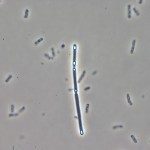Link to Pubmed [PMID] – 14990259
Res. Microbiol. 2004 Mar;155(2):80-6
The Bacillus subtilis yusCBA operon, which encodes an ABC-type transporter, contains an S-box motif in its promoter region. We showed that the expression of these genes is repressed via the S-box system when methionine is available. The YusCB proteins are involved in the transport of both d- and l-methionine but also methionine sulfoxide. A yusCB mutant is unable to grow in the presence of 5 microM l-methionine or 100 microM methionine sulfoxide, while it grows similarly to the wild type with 100 microM l-methionine and 1 mM methionine sulfoxide. Other uptake systems are therefore present for these two compounds. In contrast, the Yus ABC transporter corresponds to the sole d-methionine uptake system. We propose to rename yusC, yusB and yusA as metN, metP and metQ, respectively.

